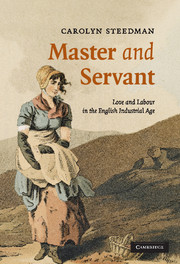Book contents
- Frontmatter
- Contents
- List of maps
- Acknowledgements
- Map 1 Map of the Haworth, Slaithwaite, Huddersfield and Halifax region, 1795
- Map 2 Sketch map of the woollen and worsted producing areas of the West Riding, late eighteenth century
- Prologue
- 1 Introduction: on service and silences
- 2 Wool, worsted and the working class: myths of origin
- 3 Lives and writing
- 4 Labour
- 5 Working for a living
- 6 Teaching
- 7 Relations
- 8 The Gods
- 9 Love
- 10 Nelly's version
- 11 Conclusion: Phoebe in Arcadia
- Bibliography
- Index
10 - Nelly's version
Published online by Cambridge University Press: 06 January 2010
- Frontmatter
- Contents
- List of maps
- Acknowledgements
- Map 1 Map of the Haworth, Slaithwaite, Huddersfield and Halifax region, 1795
- Map 2 Sketch map of the woollen and worsted producing areas of the West Riding, late eighteenth century
- Prologue
- 1 Introduction: on service and silences
- 2 Wool, worsted and the working class: myths of origin
- 3 Lives and writing
- 4 Labour
- 5 Working for a living
- 6 Teaching
- 7 Relations
- 8 The Gods
- 9 Love
- 10 Nelly's version
- 11 Conclusion: Phoebe in Arcadia
- Bibliography
- Index
Summary
Emily Brontë's Wuthering Heights (1847) has been read as a form of history before. In Heathcliff and the Great Hunger Terry Eagleton's purpose is to make Heathcliff a ‘fragment of Ireland’, some kind of embodiment of the Brontës' own Irish inheritance and of a modern history of Anglo-Irish relations. The project is to make visible the material and historical realities that are the sinews of the novel. ‘What governs interpersonal relations in Wuthering Heights’, says Eagleton, ‘is a tightly material economy of labour, kinship and inheritance. For all the critical blather about transcendent and Romantic love, few more tenaciously materialist fictions have flowed from an English pen than this genealogically obsessed work, in which law and property and inheritance are the very stuff of the plot …’ I suggest that the blather about transcendence is part of the material history that Emily Brontë penned; but I would not have been able to do this without Eagleton's noticing what is really there, in the text. You cannot just do any old thing with Wuthering Heights, but you can use Heathcliff to write a history of the tortured hunger endured by England's first colonial possession, and you can let one of its narrators, Nelly Dean, speak of the service relationship and of being a servant, because those histories are there, embedded in her as figure and in the story she tells.
A plot summary of the novel is almost certainly in order.
- Type
- Chapter
- Information
- Master and ServantLove and Labour in the English Industrial Age, pp. 193 - 216Publisher: Cambridge University PressPrint publication year: 2007

